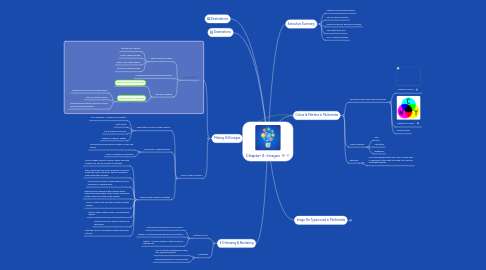
1. Making Still Images
1.1. Bitmaps (raster)
1.1.1. Photo-Realistic Images
1.1.1.1. Capture by a camera
1.1.1.2. screen capture image
1.1.1.3. photo from other artwork
1.1.1.4. scanner to digitize image
1.1.2. Complex drawings requiring fine details
1.1.3. Bitmaps Software
1.1.3.1. Adobe Photoshop & illustrator
1.1.3.2. Corel's Painter & CorelDraw
1.1.3.2.1. Enhance and make composite images
1.1.3.2.2. alter and distort images
1.1.3.2.3. morph (manipulate still images to create animated transformation)
1.2. Vector Drawn Graphics
1.2.1. Application of vector drawn objects
1.2.1.1. CAD programs - engineers & architect
1.2.1.2. print media
1.2.1.3. 3-D animation programs
1.2.1.4. drawing of graphic shapes
1.2.2. How vector- drawn graphics
1.2.2.1. line that id describe by the location of two end points.
1.2.2.2. Uses of Cartesian coordinates
1.2.3. Vector Drawn Images vs bitmaps
1.2.3.1. Vector Images use less memory space and have a smaller file size as compare to bitmaps
1.2.3.2. Web, Pages that use vector graphics in plug-ins download faster and when used for animation draw faster than bitmaps
1.2.3.3. vector objects easily scalable without loss of resolution or image quality
1.2.3.4. Resizing a bit mapped image requires either duplicating pixels while vector image, a rescaled image retais the quality of the original
1.2.3.5. Vector Images cant be used for photo realistic images
1.2.3.6. vector images requires plug-in for web base display
1.2.3.7. bitmaps are not so easily scalable and resizeable
1.2.3.8. bitmaps can be converted to vector using auto tracing
2. Destinations
3. Destinations
4. 3-D drawing & Rendering
4.1. Features of 3-D
4.1.1. Placing all the elements into 3-D space
4.1.2. Shape of a plane surface extends some distance
4.1.3. lathing - a profile shape is rotated around a defined axis
4.2. Rendering
4.2.1. Use of intricate algorithms to apply user-specified effects
4.2.2. takes many hours for a single image
5. Executive Summary
5.1. Customer and Market Analysis
5.2. Service Offer Definition
5.3. Revenue Forecast &Financial Analysis
5.4. Sales Execution Plan
5.5. Go-To-Market Strategy
6. Colour & Palettes in Multimedia
6.1. Understand the natural light and colour
6.1.1. Additive Colours
6.1.2. Subtractive Colour
6.1.3. Colour Models
6.2. Colour Palettes
6.2.1. Heu
6.2.2. Saturation
6.2.3. Brightness
6.3. Dithering
6.3.1. A process whereby the color value of each pixel is changed to the closet matching color value in the target palettes.
7. Image file Types used in Multimedia
7.1. Macintosh Formats
7.1.1. PITC.
7.2. Windows Formats
7.2.1. BMP - A windows bitmap file
7.2.2. TIFF - Extensively used in DTP packages
7.2.3. PCX - Used by MS- DOS paint software
7.3. Cross-Platform Formats
7.3.1. JPEG
7.3.2. GIF
7.3.3. PNG
7.3.4. PDF
7.3.5. PSD
7.3.6. AI
7.3.7. CDR
7.3.8. DXF
7.3.9. IGS
7.3.10. IGES
7.3.11. COLLADA 3D - STANDARD FOR TRANSFERRING 3-D FILES
7.3.12. KML - (KEYHOLE MARKUP LANGUAGE)& KMZ- (ZIPPED PACKAGE OF KML FILES AND IMAGES)
7.4. Image file compression
7.4.1. Lossy formats - JPEG FILES
7.4.2. Lossless formats - PSD, PSP, GIF, PNG, BMP, TIFF, and RAW

